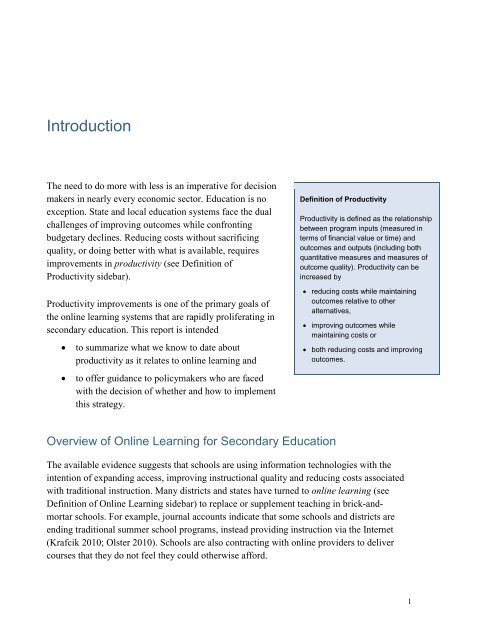Download PDF - SRI International
Download PDF - SRI International
Download PDF - SRI International
You also want an ePaper? Increase the reach of your titles
YUMPU automatically turns print PDFs into web optimized ePapers that Google loves.
Introduction<br />
The need to do more with less is an imperative for decision<br />
makers in nearly every economic sector. Education is no<br />
exception. State and local education systems face the dual<br />
challenges of improving outcomes while confronting<br />
budgetary declines. Reducing costs without sacrificing<br />
quality, or doing better with what is available, requires<br />
improvements in productivity (see Definition of<br />
Productivity sidebar).<br />
Productivity improvements is one of the primary goals of<br />
the online learning systems that are rapidly proliferating in<br />
secondary education. This report is intended<br />
• to summarize what we know to date about<br />
productivity as it relates to online learning and<br />
• to offer guidance to policymakers who are faced<br />
with the decision of whether and how to implement<br />
this strategy.<br />
Definition of Productivity<br />
Productivity is defined as the relationship<br />
between program inputs (measured in<br />
terms of financial value or time) and<br />
outcomes and outputs (including both<br />
quantitative measures and measures of<br />
outcome quality). Productivity can be<br />
increased by<br />
• reducing costs while maintaining<br />
outcomes relative to other<br />
alternatives,<br />
• improving outcomes while<br />
maintaining costs or<br />
• both reducing costs and improving<br />
outcomes.<br />
Overview of Online Learning for Secondary Education<br />
The available evidence suggests that schools are using information technologies with the<br />
intention of expanding access, improving instructional quality and reducing costs associated<br />
with traditional instruction. Many districts and states have turned to online learning (see<br />
Definition of Online Learning sidebar) to replace or supplement teaching in brick-andmortar<br />
schools. For example, journal accounts indicate that some schools and districts are<br />
ending traditional summer school programs, instead providing instruction via the Internet<br />
(Krafcik 2010; Olster 2010). Schools are also contracting with online providers to deliver<br />
courses that they do not feel they could otherwise afford.<br />
1
















